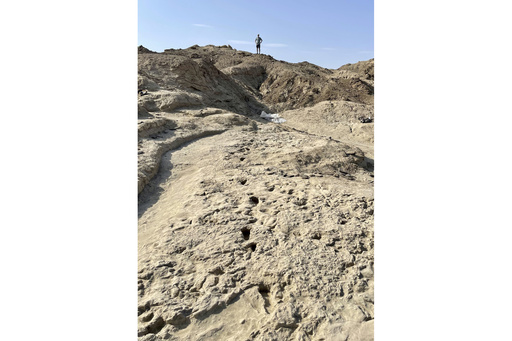
WASHINGTON — Evidence in the form of muddy footprints found on a lakeside in Kenya suggests that two distinct species of early humans coexisted in the region approximately 1.5 million years ago. These footprints were created by Homo erectus and Paranthropus boisei, which lived in close proximity during that time, as reported by paleontologist Louise Leakey, a co-author of a recent study published in the journal Science.
While scientists have long established through fossil remains that these two human ancestors inhabited the Turkana Basin concurrently, dating these fossils often provides imprecise timelines. Paleontologist William Harcourt-Smith from Lehman College and the American Museum of Natural History, who was not part of this study, notes that fossil dating can only be accurate to a range of a few thousand years. However, the discovery of actual footprints preserves a precise moment in history, marking it as a significant finding.
The fossilized tracks were initially discovered in 2021 at Koobi Fora, Kenya. Leakey, affiliated with Stony Brook University in New York, commented that the two individuals likely walked by the eastern shore of Lake Turkana within a short interval, either simultaneously or just days apart. Study co-author Kevin Hatala, a paleoanthropologist at Chatham University in Pittsburgh, suggests that it is plausible the two hominins were aware of each other’s presence and may have had some level of interaction.
Researchers identified the two species based on the differing shapes of their footprints, which provided insights into foot anatomy and movement. It appears that Homo erectus exhibited a walking style akin to modern humans, characterized by a heel-first strike followed by pressure rolling from the heel to the ball of the foot and toes. In contrast, Paranthropus boisei, also a bipedal species, demonstrated a unique walking style that researchers have never observed previously, according to co-author Erin Marie Williams-Hatala, a human evolutionary anatomist at Chatham.
The footprints indicate a greater range of motion in the big toe of Paranthropus boisei compared to both Homo erectus and contemporary humans. Researchers hypothesize that our ancient primate ancestors developed hands and feet that were suitable for grasping branches, but as evolution progressed, these adaptations shifted toward promoting bipedal locomotion. This study contributes to an expanding understanding of how early humans adapted to walking on two feet, suggesting this change was not a singular event but rather a gradual process with various styles of bipedal movement taking shape.
In essence, the findings point to the fact that there were multiple methods through which early humans could traverse the landscape, indicating a diversity of locomotion styles. “It turns out, there are different gait mechanics — different ways of being bipedal,” states Harcourt-Smith, emphasizing the complexity of human evolution.
